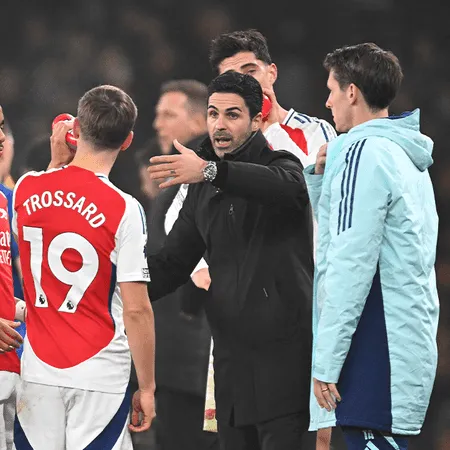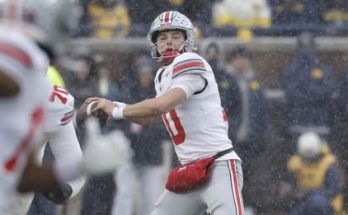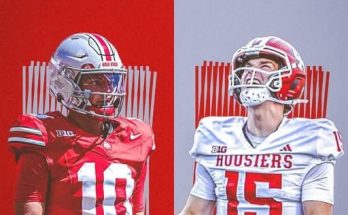We made it 17 games unbeaten at Emirates Stadium with Friday night’s 1-0 win over Ipswich Town.
To discover how we dealt with a defensive Ipswich, Adrian Clarke has poured through the footage and stats to unearth these five key takeaways from the game:
AN ASSURED DISPLAY FROM LEWIS-SKELLY
Completing 90 minutes for the first time as an Arsenal first teamer, 18-year-old Myles Lewis-Skelly excelled once again in an inverted left back position.
Defensively, the youngster made sound decisions all game long. Positionally intelligent, he was also strong in his physical duels, winning a game-high nine out of 12.
That level of success rate is fast becoming the norm for Lewis-Skelly, who tops Arsenal’s rankings in this department with a seriously impressive 73.08 per cent of duels won.
The only Premier League player, with a minimum of three starts, who can better that record is Aston Villa’s Ezri Konsa on 75 per cent.
Our latest Hale End graduate also looked after the ball supremely well in this encounter.
Misplacing just one pass from 59 attempts, Lewis-Skelly’s 98.3 per cent accuracy was comfortably the best on show.
Considering he slides into a congested midfield domain to link play in tight areas much of the time, his natural assurance in possession is a huge asset to the side.
Keeping his distribution simple, he is a young talent that his teammates trust implicitly with the ball at his feet.
Remarkably, Lewis-Skelly currently has the best passing accuracy of all Premier League players to have made at least three starts.
In this, his first season at the level, the teenager is showcasing extraordinary calmness.
Intuitively knowing when to pass early, when to embark on a dribble, and when to use his strength to dominate opponents, Lewis-Skelly is displaying fantastic potential.
A MULTI-FUNCTIONAL ROLE FOR MATCH-WINNER HAVERTZ
With in-form Gabriel Jesus keeping his place up front, Mikel Arteta deployed Kai Havertz as a central midfielder for the second match in a row.
Early on in his Gunners career the German was perhaps guilty of being too disciplined in his positioning on the left of an engine room trio, but that is no longer the case.
He now effortlessly moves around the pitch to impact matches from that position, exuding positional intelligence.
Just as he did against Crystal Palace, Havertz popped up inside the six-yard box to score a crucial goal.
When the ball is wide, the team needs him to join in as a second striker- and because he makes his runs from deep in that role, the 25-year-old can be difficult to pick up.
Leandro Trossard’s brilliant run and cross from the left showcased his confidence with both feet, but without Havertz making up ground to meet his excellent delivery, Arsenal may not have taken a 23rd minute lead.
Havertz also took a leaf out of Granit Xhaka’s book by drifting towards the left wing when Lewis-Skelly slipped inside to join in as a central midfielder.
It is quite a departure from what is asked of him as a centre forward, but our number 29 is happy to take up those positions as part of our rotation in possession.
This shot below shows how we sometimes morphed into a 3-4-3 in the build-up phase with Havertz wide left and Odegaard the furthest right in our midfield.
Havertz’s clever movement was at the heart of the best pattern of play we produced in this fixture.
Drawing the Tractor Boys wide to open up a hole between their three centre backs, this lovely triangle sent the German clear down Arsenal’s left in the second half.
This is the type of move we should try and replicate when coming up against stubborn, defensive teams.
Credit should also go to Odegaard and Trossard for seeing the picture nice and early.
FRUSTRATED BY IPSWICH’S DEFENSIVE APPROACH
Kieran McKenna’s newly promoted side started in a 3-4-2-1 formation that immediately became a deep-lying 5-4-1 block that was difficult to break down.
It was only the second time this season the Tractor Boys chose to play this way (the other was Manchester City away) in a clear sign of their determination to stifle our game.
During the first half we enjoyed 84% of possession, making an incredible 444 passes.
It was the highest share in a first half this term, and the biggest when it has been 11v11.
The only two larger percentages came in halves of football where the opponent had been reduced to ten men.
| team | opponent | half | possession |
|---|---|---|---|
| Manchester City | Arsenal | Second | 87.6% |
| Southampton | Newcastle United | Second | 84.4% |
| Arsenal | Ipswich Town | First | 84.0% |
| Arsenal | Everton | Second | 80.0% |
| Brighton & Hove Albion | Crystal Palace | Second | 79.9% |
Just a handful of our first half passes found teammates inside the danger zone however, with the visitors’ blue wall limiting us to just four shots.
Not since a home clash against Newcastle United in April 2019 have we seen as few shots (also four) in a first half of a league game at Emirates Stadium.
From half-time onwards the game changed, with Ipswich showing far more ambition, even making slightly more passes than Mikel Arteta’s men.
Halving our own pass count, we found it easier to play in a more vertical, direct manner – and this helped us manufacture a greater number of dangerous attacking situations.
| arsenal – ipswich | 1st half | 2nd half |
|---|---|---|
| Possession % | 84-16 | 49.3-50.7 |
| Passes | 444-85 | 226-233 |
| Touches in opp box | 24-0 | 16-5 |
| Shots | 4-0 | 9-3 |
| XG | 0.88-0 | 0.98-0.15 |
While it remained frustrating at times, this change of tact showed that a little less control can make us a more menacing side to face.
Having less of the ball can open up extra space for us to launch attacks, and this was evident against the promoted side.
CARRYING THE BALL WITH INTENT
When a rival team sits back with so many defenders behind the ball, dribbling becomes an even more important weapon.
Ipswich marked space very well on the night, but whenever an Arsenal man took it upon themselves to carry the ball at speed, they didn’t like it.
Jurrien Timber’s superb burst down the middle went untracked, helping the right back register a first half shot on target.
The skipper Martin Odegaard followed suit in the second period, driving forward to produce two fabulous slalom dribbles that ended with the Norwegian firing off shots.
It was pleasing to see these two individuals recognising this was a tactic which suited the game.
Declan Rice’s shooting was also a weapon we could have used more on the night.
With Ipswich regularly dropping nine outfielders into their own box, it was often on for the England international to shoot from distance.
With nobody close enough to close him down, Rice was unlucky not to score from this fierce 22-yard strike.

ANOTHER DEFENSIVE SHUTOUT
While we would have liked to won a little more convincingly, it should not be ignored that our opponents caused us next to no defensive problems.
Limiting Ipswich Town to just three shots and an XG of 0.15 (their lowest of the season) we ensured this was a restful evening for goalkeeper David Raya.
Only seven times have teams managed three or less shots in a Premier League game so far in 2024/25, and three of those occurred against Arsenal in December.
On the back of Fulham and Everton mustering just two efforts apiece, this was another reminder of how solid we have been in recent weeks.



